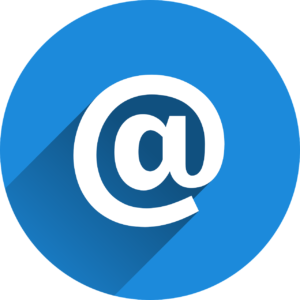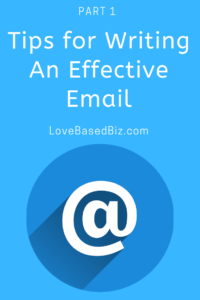Note: This is the first post in a two-post series, where I’m sharing my favorite strategies for writing an effective email that convert prospects into buyers or leads into customers.
In today’s world—the world of building businesses online—most entrepreneurs understand that building an email list is extremely important.
An email list is one of the best ways to build your business because it gives you the opportunity to connect with potential buyers on a personal, authentic level.
But (you knew that was coming, right?) an effective email is only as effective as your open and click-through rates.
If nobody’s opening your emails, and nobody’s clicking on the links you put in them, then your email list is not actually working to build your business.
And that can be discouraging.
It takes lots of time, energy, mental power, and money to build a list and to write content regularly.
So today, I’m going to share three of my favorite tips for writing an effective email that converts (and I’ll share three more in my next post).
Tip 1. Make Sure Your Emails Are Mobile-Friendly.
I know. It sounds pretty obvious. Also, emails not being mobile-friendly doesn’t really sound like a deal-breaker, right? Wrong.
Here’s the thing: an increasing number of studies and statistics show that a growing number of people use phones and tablets to shop (not computers). In fact, one of the reports I read said that up to 70% of sales happen on phones or tablets.
If your emails look “off” or load improperly and aren’t easy to read, your readers are going to click “delete,” period.
So here are some mobile-friendly-related considerations to make as you create and compose your emails:
- Whether to use a banner. Recently, I’ve noticed that entrepreneurs see better conversion rates when they do not use a banner.
- The user experience: technically. People reading on teeny tiny mobile devices are more likely to skim than people who read on computers. Make it easy for people to consume your emails by incorporating white space, shorter paragraphs, and shorter sentences.
- The user experience: emotionally. Be sure to think about how your subscribers feel when they get your email. They’re living, breathing, busy people, so give them something worthwhile.
Tip 2. Make Your Emails Easy-to-Read and Understand.
As I mentioned above, your ideal prospects are likely skimming your email. That being said, is it easy for them to follow what you’re saying? Are you using words they quickly and easily understand?
Are you making them think too hard?
Of course, I’m not saying you should “dumb down” your message. But you should also be sure to use language that your ideal prospects use (not jargon from your industry).
On another note, be crystal clear about which action you want your readers to take. Set links apart so readers know exactly where to click. If it’s not crystal clear, your readers likely won’t take action at all.
One of my favorite tips for creating a crystal clear call to action is to start with the end in mind. Before you even start writing the email, be clear in your own mind about which action you want readers to take—whether it’s to enroll in your new course, buy your book, or read your newest blog post.
Building your email that call to action is a great way to make sure you’ve just created an effective email. And don’t forget to keep it simple!
Tip 3. Connect with Your Ideal Prospects.
Your community is unique. It’s important to ensure you are connecting with the members of your community on a personal level.
Here are a couple of examples:
I’m on a list where the business owner writes very long emails a few times each week. To be honest, although I’m seeing better conversion rates with shorter emails, this entrepreneur’s emails are entertaining—a great mix of content and stories from his life.
And, they always include some kind of offer at the end.
I’d typically caution entrepreneurs against sending out too many sales emails, but this particular business owner has it nailed: I am certain he gets a lot of email opens and a lot of click-throughs because his emails are informative and entertaining!
One of my clients has had a great response from shorter, punchier emails that have a kind of “hook.” She’s often directing people to read her blog posts, and she makes her emails short and sweet and to the point. Although this effort is the opposite of the one I explained in the first example, it works!
It’s all about knowing what your ideal prospects want from you.
In Conclusion…
The next time you sit down to write an effective email, I’d encourage you to keep these tips in mind. When your emails are easy to read, when they are easy to understand, and when they resonate with the members of your community, you’ll see your conversion numbers improve.
And your business will grow as a result.
Check out Part 2 and the next 3 tips right here.
Meanwhile, if this topic resonates with you, you may be interested in my book, “Love-Based Copywriting System: A Step-by-Step Process to Master Writing Copy that Attracts, Inspires and Invites.” It’s available here.

 How to Succeed as a Writer
How to Succeed as a Writer A Little Secret About Sabotage (Compliments of Cutthroat Kitchen)
A Little Secret About Sabotage (Compliments of Cutthroat Kitchen) 3 Keys to Making Money with Your Passion
3 Keys to Making Money with Your Passion 5 Hot Ways to Market Your Book (and Your Biz) in 2020
5 Hot Ways to Market Your Book (and Your Biz) in 2020 3 Ways Gratitude Can Grow Your Business
3 Ways Gratitude Can Grow Your Business
[…] Note: This is the second post in a two-post series, where I’m sharing my favorite email writing tips that convert prospects into buyers or leads into customers. For Part 1, go here. […]